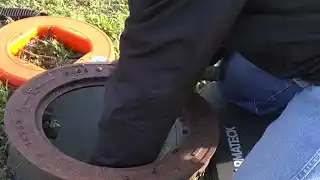Your sewer cleanout is an essential component of your plumbing system, yet many homeowners don’t fully understand its purpose or importance. Whether you’re dealing with a clogged drain, conducting a sewer inspection, or testing for leaks, the cleanout provides crucial access to your sewer line. In this guide, we’ll explore the purpose of sewer cleanouts, how they work, and why they’re a lifesaver for both homeowners and plumbers.
What Is a Sewer Cleanout?
A sewer cleanout is a capped pipe located outside your home, typically 3 to 5 feet from the foundation. It provides direct access to your main sewer line, allowing for inspections, cleaning, and testing. Modern systems often feature two-way cleanouts, which offer even greater functionality.
Three Reasons Sewer Cleanouts Are Essential
1. Quick Relief from Sewer Backups
If your sewer line becomes clogged, wastewater can back up into your home. A cleanout allows you to release the pressure and stop the mess from spilling into your bathroom or kitchen.
- How to Use It:
- Carefully loosen the cleanout cap with pliers while keeping your foot or hand over it to control any pressure release.
- Be prepared for wastewater to flow out; this prevents it from backing up inside your home.
- Pro Tip: Be cautious—sewer backups can be messy, so have a plan for cleanup afterward.
2. Easy Access for Sewer Cleaning and Repairs
Cleanouts provide plumbers with direct access to the sewer line, making it easier to address clogs or inspect for issues.
- How It Works:
- The cleanout closest to your home allows plumbers to feed a cable or sewer machine into the line to clear blockages under the house.
- The cleanout facing the yard or street is used to clear stoppages heading toward the city main.
- Avoid Mistakes: Plumbers must carefully navigate tools to avoid damaging pipes or fixtures inside the house.
3. Essential for Sewer Testing
Two-way cleanouts are invaluable for conducting sewer tests, such as water tests to check for leaks under the house.
- How It’s Done:
- Insert a test ball into the cleanout to create a seal between the house and the yard.
- Fill the sewer line with water and monitor the water level to identify leaks.
- Why It’s Important: Testing ensures your sewer system is functioning properly and identifies leaks before they cause major damage.
How Are Sewer Cleanouts Installed?
Sewer cleanouts are installed:
- Near the House: Typically 3 to 5 feet from the foundation for easy access to sewer lines under the house.
- At Key Intervals: For long sewer lines, cleanouts may be required every 75 to 100 feet and at major direction changes to facilitate cleaning and inspections.
Types of Sewer Cleanouts
1. Two-Way Cleanouts
- Allow access to both directions of the sewer line.
- Feature double combinations to direct tools either toward the house or the city main.
- Ideal for clearing blockages and conducting sewer tests.
2. Single Cleanouts
- Provide access in one direction only.
- Useful for short or straightforward sewer lines.
How to Use a Sewer Cleanout
- Locate the Cleanout: Identify where your cleanout is installed, typically in the yard near your home.
- Remove the Cap Carefully: Use pliers or a wrench to loosen the cap, keeping your hand or foot over it to control pressure release.
- Address the Issue: Whether clearing a blockage or running a test, use the cleanout as the access point.
- Close It Back Up: Once the work is done, securely tighten the cap to prevent odors or pests from entering.
Final Thoughts
Sewer cleanouts are an essential feature for any plumbing system, providing easy access for cleaning, testing, and preventing messy backups. Whether you’re a homeowner or a plumber, understanding how to use and maintain cleanouts can save time, money, and frustration.
If your home doesn’t have a sewer cleanout, consider having one installed—it’s a small investment that can prevent major headaches down the line.




